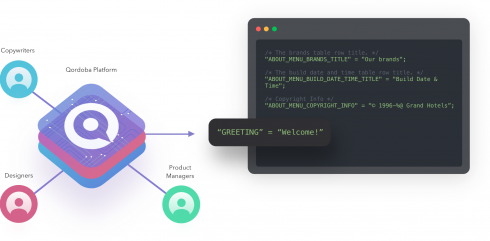
Different (key)strokes for different folks. That’s sort of the idea behind Qordoba, which has been created on the belief that application experiences should be more customized to the user, and that words — along with artificial intelligence — can and should be the driver of those experiences.
Managing strings of text manually can be tedious, and personalizing applications is not something software engineers have typically done. Product personalization has been the bailiwick of marketers working with the product development team. Qordoba is looking to change that with its Strings Intelligence Platform.
“Our strategy is to establish strings management as a standard part of a best-practice application development stack, and really evangelize all the things you can do once you’ve freed yourself from having to do this manually,” said May Habib, co-founder and CEO of Qordoba.
Visual cues in applications are often confusing, as not everyone construes, say, a square box the same way, or understand what it is meant to do. Words offer clarity, but only if you speak to users in the way they most want to be spoken to. Qordoba platform users can create and train AI models for tone and emotion, which Habib explained is “pretty standard” in language analysis. “On the emotion side, we use the big five framework of personality that psychologists have been using for years and applying it to text. On the tone side, it’s a similar Natural Language Processing framework around the analysis of text.”
The fact that a content copywriter can see in real time how what he or she is writing aligns with the tone guidelines set by editorial leadership, Habib said. A number of questions and sliders help copywriters create content in the way a company’s marketing would want it so sound.
But what Habib described as a big differentiator is that this happens right where the content is being created. “Unlike an IBM Watson, I’m not putting a bunch of content in an API, getting analysis, then having to go back to where I’m writing and revise it and rewrite it. It’s literally happening at the place of authorship.”
“We know a lot about how products get built, and things like integrating into the Adobe ecosystem, and integrating into Sketch, allows a copywriter who’s just had her work revised – with the help of Qordoba’s content AI, look at what she’s written back in the design tools and make sure it makes sense from a broad UX perspective.”
Meanwhile, software engineers are happy because they’ve got resource files and strings being pulled into their flow in an agile and continuous way, Habib noted.
The Qordoba platform also can give guidance to copywriters. “Our ability to right away notice that in some repo or other, the word Quickbooks has the b lowercase, but someone changed it to uppercase. We learn, and propagate that suggestion everywhere. And that’s not rule-based; it’s actually machine-learning based.”
A more complex example of that capability is having the platform flag you if you’re violating established content style. “Say your guidelines indicates you want a reading level of grade 8 or 9, yet you’ve used a word more sophisticated than that, so how about using this word? Or, the persona that you’ve tied the style guide to tells us you want to be targeting millennials with this version of your copy, so how about making this punctuation less formal or not capitalizing so many of these proper nouns? That’s the more advanced stuff we’re rolling out,” Habib said.
Yet Habib also said natural language generation – the ability automatically generate cool sentences, for instance – is still something that is further off.
Another elegant application of AI in the platform, according to Habib, is that it can automatically tag a string that is an error message, by training a model on how people write these messages, and what an error message looks like, so we’re automatically suggesting a tag that can be added to a string that’s an error message. And, being that we automatically generate keys, being able to also add a subscript error message to a key makes it much easier for engineers in their own code to search for error messages.”
Text in source code is a rich area to apply machine learning techniques. Habib is trying to spread the word.






